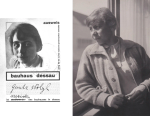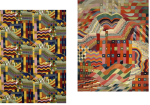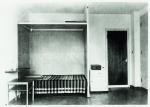Modernist Estates × Wallace Sewell offer
Gunta Stölz and the Prellerhaus Blanket

Left: Gunta Stölzl © Sascha Wagner via Wikimedia License Under Public Domain. Right: Gunta Stölzl, 1929, Courtesy Stölzl estate © Monika photo
Growing up in a middle-class town with a progressive, left-leaning atmosphere, however, provided some cultural influence. I was drawn to friends whose homes were the opposite of mine. My best friend’s parents, for example, were an artist and a textile designer. They weren’t rich or flashy, but they had good taste, and their house felt lived-in. I remember the warmth and comfort of being in their home.
When I was studying for my A-levels, I had a part-time cleaning job (if you’re a long-time follower, you’ll know I used to clean Dame Vera Lynn’s house). It was the perfect opportunity to snoop into other people’s homes. Whenever I visited someone’s house, I’d make a mental note of pieces of furniture and furnishings I liked, storing them away for future reference. One such item was a sofa covered in a bold abstract fabric of checkerboard squares and swooshes in bright primary colours. A school friend had the same fabric in her bedroom. The design stuck with me, and years later, when I bought my own flat and was able to choose my own furniture, I tracked it down on a new thing called THE INTERNET: Bauhaus, designed by Collier Campbell for Liberty, originally in 1969 as a silk scarf for Cacherel. I managed to find someone in America selling several metres (yards) of it on eBay, bought it immediately, and made several cushions out of it—cushions I still have today. It was only later that I learned the design was inspired by a 1926–27 tapestry by Gunta Stölzl.

Left: Bauhaus, designed by Collier Campbell for Liberty, 1972 Right: © Gunta Stölzl, Red-Green Slit Tapestry, 1927–1928
Born in 1897, Stölzl studied at the Munich School of Applied Arts before serving as a Red Cross nurse in 1917—an experience that profoundly shaped her worldview. After the First World War, she resumed her studies in Munich but soon joined the newly established Bauhaus in Weimar in 1919. Recognising the limited opportunities for women at the school, she proposed a women’s department in 1920. Bauhaus director Walter Gropius approved—not out of progressive intent, but to confine female students largely to the weaving workshop. Nevertheless, Stölzl embraced this role, transforming the workshop into a space where craft, colour theory, and modernist design principles merged.
The school relocated to Dessau and initially under the leadership of Georg Muche, the weaving workshop faced ongoing dissatisfaction. In 1927, Muche resigned, and Stölzl was appointed Master of Form, effectively taking charge of the workshop—making her the only female Master at the Bauhaus. She played a key role in reshaping the perception of weaving, challenging its association with ‘women’s work’ and establishing it as an art form. She continued this effort throughout her time at the Bauhaus. However, as the Nazi party gained power in Germany, the school faced increasing political pressure to conform. Unwilling to compromise her values, Stölzl was dismissed in 1931. The Bauhaus itself was shut down by the Nazis the following year.

Original dormitory at Bauhaus Dessau
One of Stölzl’s most iconic designs was the Prellerhaus blanket, originally woven in 1926 for the dormitories at the Dessau campus. Over 100 blankets were handwoven by students in the workshop, though none survive today. In honour of the Bauhaus centenary in 2019, London-based design studio Wallace Sewell, in collaboration with Stölzl’s daughter Monica Stadler, reissued the blanket using archive drawings and photographs as reference. Sketches and colour swatches led to more detailed design development, undertaken by hand on small looms in the Wallace Sewell studio before weaving full-scale pieces at a mill in Lancashire. The original blankets were likely woven from ‘modern’ fabrics like rayon, but Wallace Sewell reimagined the design in wool—a more desirable and sustainable choice today—while alsointroducing new colourways.
I first heard about this collaboration while working on an exhibition project at Bauhaus Dessau in 2017, where I was lucky enough to stay in the original dorms—which you can stay in too. Just as the Bauhaus Liberty fabric became an obsession years ago, I coveted the Prellerhaus blanket, but couldn’t quite afford one at the time. Finally, last year, I bought it—and I think you’ll agree that my sofa and the blanket were made for each other. Now, thanks to a special collaboration between Modernist Estates and Wallace Sewell, you can own one too—at half the price.
Modernist Estates × Wallace Sewell 50% Discount Offer
To coincide with Stölzl’s birthday, we have teamed up with Wallace Sewell to offer a huge 50% discount on their large Indigo Bauhaus throw (pictured)—originally £575, now £287.50 for a limited time only. The discount will be available online and in-store from 5–9 March 2025. No code is needed.

